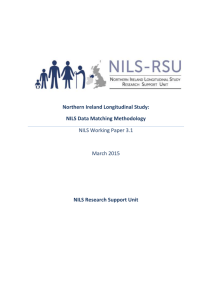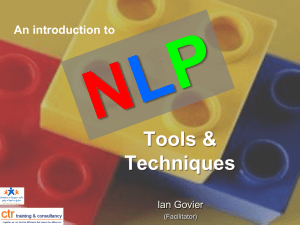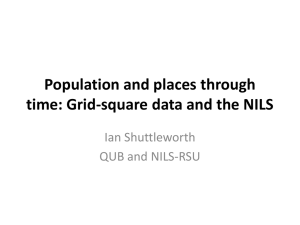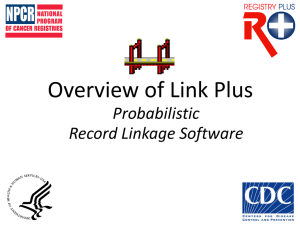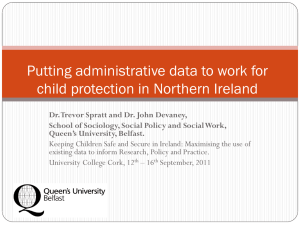NILS Working Paper 3.0 (DOCX 905kB)
advertisement
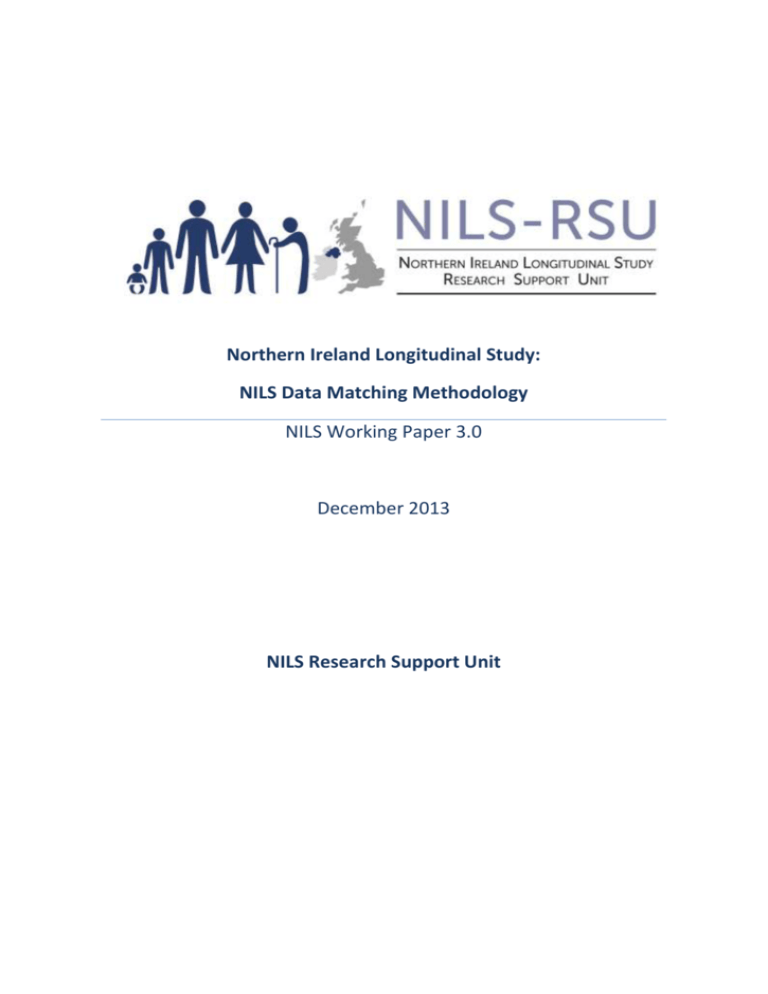
Northern Ireland Longitudinal Study: NILS Data Matching Methodology NILS Working Paper 3.0 December 2013 NILS Research Support Unit 1. Introduction The NILS is a large-scale record linkage study of approximately 500,000 people (a representative c. 28% sample of the Northern Ireland population) that has been created by linking statistical and administrative data sources within Northern Ireland. These data include the 2001 and 2011 Census returns, demographic and migration events and vital events (births and deaths). The NIMS is an additional major record linkage study that links the 2001 Census returns for the whole of the enumerated population (approximately 1.6 million individuals) to subsequently registered mortality data. For a detailed introduction to the NILS and NIMS, please refer to the NILS Research Support Unit website1. This working paper provides a generic description of the technical methodology used to create linkages between each of the available NILS data sources. 2. Data Matching Objective As with any data matching exercise, the objective is to join two datasets together based upon a common entity. The ‘Spine’ of the NILS can be described as a sample of people registered with a General Practitioner in Northern Ireland. It is these people who are considered to be the common entity to link between in each of the NILS data sources. To carry out a linkage between each dataset, certain information is used from each entity to compare and confirm/refute any potential linkage between datasets. The quality of matches between datasets is based upon the uniqueness of this information and similarity of data capture in each of the data being matched. Typical information used across the NILS datasets includes name (forename(s), surname, previous surnames), gender, date of birth and address information. Table 1 shows a list of the main NILS data sources and provides a description of how each of the datasets is populated. Table 1: NILS Data Sources and Data Collection method Data Collection Description Health Card data is collected using a combination of historical medical records and new Registration information collected from GPs, hospitals, dentists and provided by (Core NILS Data) patients. This data is referred to as Health Card Registrations. Census (2001, 2011) a member of the household completes a form in on behalf of everyone within the household and then the details are scanned in using optical character recognition. In the 2011 Census, an online form was also available for each household. GRO Births information gathered from face-to-face interview with informant of birth – usually the mother or father of baby GRO Deaths information gathered from face-to-face interview with informant of death – usually a relative of the deceased 1 www.nils-rsu.census.ac.uk 2|Page The variety of ways that the data is collected and the amount of verification applied before the data is entered onto the systems invariably mean that the data will not be identical on all systems. The differences may be minor, such as a slightly different spelling of the surname or they could be significant such as an incorrect address, date of birth or a middle name used in place of a forename. Therefore it is important to ensure that any matching algorithms take account of non-exact matched records. 3. NILS Data Matching Process There is some variation in matching methodology between datasets due to individual characteristics of each data source. However, there is a general approach adopted when matching new data into NILS/NIMS for the first time. This takes the form of: i. ii. iii. iv. v. vi. Data preparation; Automated data matching; Step 1 – Manual verification of automatic data matching; Step 2 – Multiple choice; Step 3 – Manual search; and Step 4 – Cross verification and Quality checks. As previously mentioned, when matching data into the NILS, the reference or ‘spine’ data source is the Health Card Registration data. For the NIMS 2001 the reference data source is all 2001 Census records i. Data preparation The aim of the data preparation stage is to standardise corresponding match fields within the two data sources to be linked. At this stage the data is analysed to assess the key matching fields for quality and comparability to the reference data source. All identified issues are resolved where possible and two bespoke datasets are created for the automated matching phase. Using the linkage of 2011 census data into the NILS as an example, it was identified that some name information was of lower quality (missing, mis-spelt etc) due to the Optical Character Recognition phase of scanning the 2011 forms. A clerical exercise was undertaken to correct these before matching proceeded. Other anomalies include name information only including the persons’ initials, postcodes in different formats, nicknames used rather than common names, day of birth transposed with month of birth etc. ii. Automated data matching Following the data preparation phase resulting in the creation of two bespoke datasets, an automated matching routine is created and run to produce potential linkages between the datasets. This process 3|Page utilises a combination of SQL Server Integrated Services (SSIS) interacting with a dedicated record linkage software package called Fine-Grained Records Integration and Linkage Tool (FRIL)2. During this process the SSIS uses FRIL to carry out a number of data linkage cycles between datasets using a different configuration at each stage taking account of variation in the fields used. A match confidence score is assigned to each record pair based on the strength of similarity between matching fields. The number of records processed is reduced during each matching cycle with records associated with strong matches removed before the next cycle runs. As a result of the automated matching phase the data can be divided into three sections: a) One-to-one data matches having a match score identified as being over a pre-determined threshold; and b) Data matches where the match score is above the threshold mentioned in a) but linked to more than one person; or one-to-one matches with a match score below the threshold; and c) Unmatched records. iii. Step 1 – Manual verification of links Following the automated matching process, a random sample of the one-to-one data matches mentioned in section a) of the previous section is manually verified by matching staff. The objective of this phase is to affirm the quality of matches produced in the automated matching phase. At this stage, matching staff visually compare information from the two linked datasets using bespoke Graphical User Interfaces (GUIs). The matching staff have the ability to take additional information into account (names, addresses, age, gender, other household members etc) and confirm/refute any automatically generated matches. If a considerable number of rejected links are identified then further ‘tuning’ work may be carried out on phase ii and the automated matching re-run until satisfactory matching levels are reached. iv. Step 2 – Multiple choice The fourth phase of NILS data matching involves looking at two types of data matches generated from the automated matching phase: Data matches where the match score is above the pre-determined threshold mentioned in a) but linked to more than one person; and one-to-one matches with a match score below the threshold. Again, matching staff use specifically designed GUIs to look at information from the potentially linked datasets and to confirm/refute the generated matches. Any records rejected are passed to the next stage - manual searching. 2 http://fril.sourceforge.net/ 4|Page v. Step 3 – Manual search Following the processing of all potential matches identified from the automated matching phase, there are usually some residual records identified as not being linked to the NILS/NIMS. For the manual searching phase, matching staff use GUIs to manually search for further matches between the datasets. Staff can enter individual search criteria for each record and can be more relaxed/stringent with the criteria as they feel is suitable. This stage completes all the potential matches. vi. Step 4 – Cross Verification and Quality checks On completion of the manual matching phase, all links will have been created and a further manual verification exercise is carried out on the links to identify errors and quality. An analysis is carried out on the linkages and other information to identify any inconsistencies between datasets. Linkages associated with any discrepancies are marked up for manual verification and checked in the same manner as described in phase iii of the matching process. Some examples of the analysis include: Births to NILS members – number of linkages for the mother exceed the total of previous births as noted in the GRO births file, dates between births appear incorrect as they are too close together, DOB of the baby is different on the Health data and the GRO data; and Deaths – discrepancies between address and registration district, health data not marked as NILS member being deceased, differences in the persons name and different date of birth on the Health data and the GRO data A random sample of matches similar to those described in phase iii are also included for verification as a quality check on the entire matching process. The results of Step 4 – Cross Verification and Quality Checks are analysed for consistency and if no issues are identified then the matching work is marked as complete. If any potential issues are identified then there is remedial work carried out to resolve the issues, which may include more manual verification, before the matching is marked as complete. 5|Page 4. Results This matching method has been used to create the links in the NILS and NIMS datasets. Below is a table showing the number of matches and the typical match rate that has been achieved using this methodology. Type of Linkage NILS NIMS Health Card Registrations to Census 2001 Records Linked 452,600 Match Rate3 97.1% Health Card Registrations to Deaths 42,300 97.7% Health Card Registrations to Births (babies) 98,000 98.1% Health Card Registrations to Births (dads) 88,600 95.3% Health Card Registrations to Births (mums) 99,600 99.7% Census 2001 to deaths 135,900 94.1% 5. Conclusion Considerable research and experience has gone into the development of the NILS matching process. This has resulted in an optimum matching methodology that generally yields a high match rate when linking NILS and NIMS data. Matching methods are continually changing and developments in technology enable more efficient matching to be implemented. Therefore a review of the NILS/NIMS matching methodology will be completed in 2014. NISRA December 2013 3 The numerator is the number of matched records, the denominator is the estimate of the number of records that would be expected to be matched 6|Page

